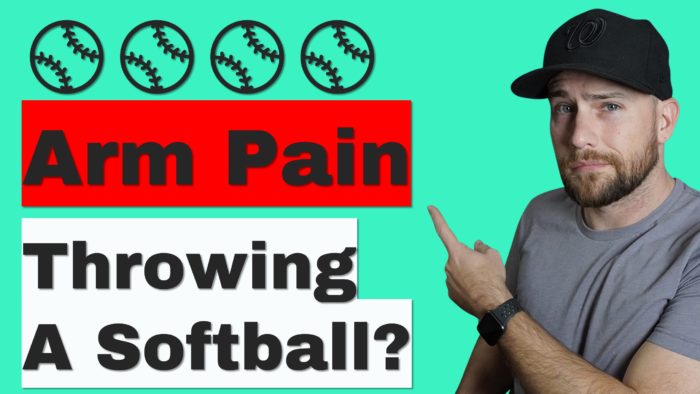*This article may contain product links which pay me a small commission if you make a purchase. Learn more.
It’s not uncommon for softball players to have pain while throwing. Typically, this is due to a few factors–poor throwing mechanics, a weak shoulder, a poor throwing progression, or more. Learn how you can potentially ward off pain while throwing a softball in this article.
This article on throwing pain in fastpitch softball players is a two-parter. When part two is complete, it will be linked here.
FIRST! A Player Should Never Be in Pain Throwing a Softball.
Some parents, players and coaches hold onto the idea that as a high-level player who plays lots of games, some amount of pain is normal.
FALSE! Throwing through pain is NEVER normal.
Sure – too many games can definitely cause pain in and of itself–overuse is a chief cause of softball throwing injuries. Make sure you’re considering this as well before any of the mechanical issues in this article.
I highly recommend watch this video of mine that goes into the process for figuring out arm pain.
No matter how good a player’s mechanics might be, overuse injuries will still happen if you play an excessive amount of games. Be sensible.
This is the first thing you should realize–as a parent, coach or player. Pain is NOT part of the game, and it should be address by a physical therapist, doctor, and a coach who can help improve throwing mechanics for the long haul.
In this article, we’ll touch on the following:
- Mechanical flaws that cause pain
In part 2, we’ll cover strength issues that can cause or prevent pain:
- Shoulder issues that can cause pain
- Hip issues that can cause pain
Please Note! I am not a doctor and am NOT diagnosing or prescribing any cures in this article. Pain should always be brought to the attention of a doctor and any advice in this article is general and not specific to your individual case. The goal is to inform you as to possible causes and things that correlate with pain, and exercises that can help ward it off, but are in no way guarantee or implied to do so.
Three Common Mechanical Flaws That Cause Pain
Pretty much all of the research done on overhand throwing is done on baseball pitchers. Why? Because Major League Baseball loses millions of dollars each year on injured pitchers.
Fortunately, the biomechanics are not very different from pitching to position throwing, and women throw in the same way as men do.
The demands are slightly different in softball–as is the ball itself–but the throwing motion is no different for a baseball infielder than a softball infielder. What we learn from baseball research is definitely applicable to softball. So bear with me.
The flaws below are NOT my opinion–they follow the research guidelines of the American Sports Medicine Institute.
Softball Throwing Flaw #1: Poor Elbow Angle
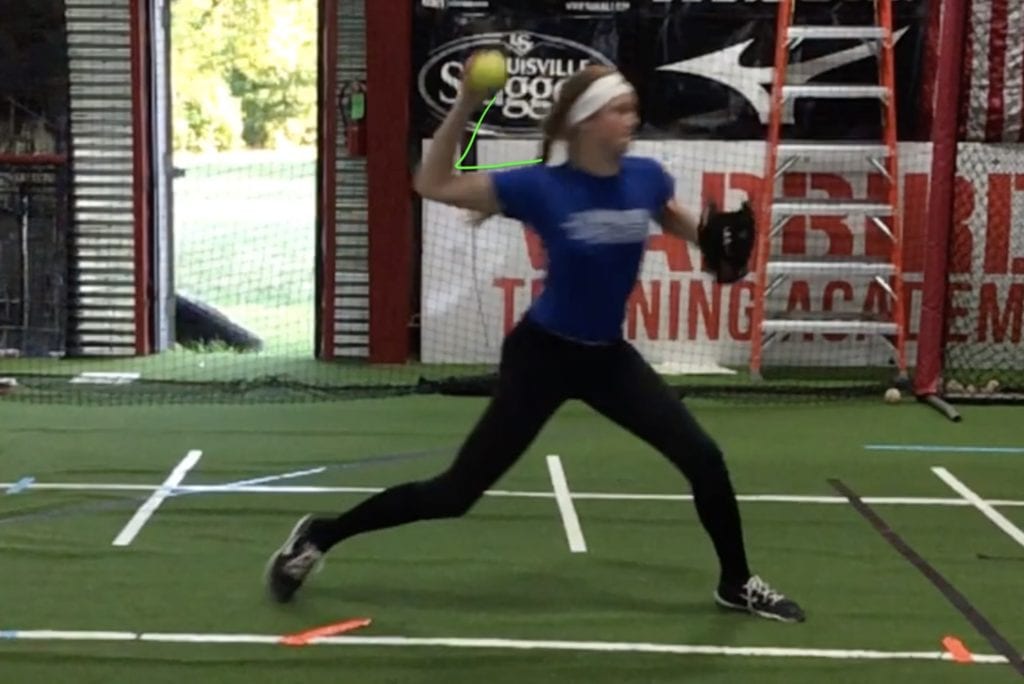
The elbow angle should be +/- 90 degrees according to research on baseball pitchers. So following this 90 degree guideline is a good idea with one exception:
Observable angles in high-level (college and pro) position players is typically (but not always) less than 90 degrees.
What the research shows is that angles GREATER than 90 tend to increase stress, and angles MUCH lower than 90 increase stress. Yet, observing elite baseball and softball players reveals that most infielders and catchers throw with an elbow angle in the 60-80 degree range.

What happens when the elbow angle gets larger than 90? Basically the stress on the elbow and shoulder increase because the lever–the arm–is effectively larger.
Here’s one of my softball clients. I know the photo isn’t great, but it was taken from a grainy slow-motion video she sent as we worked together.
She’s a D2 catcher and has made huge progress taking my online throwing course.
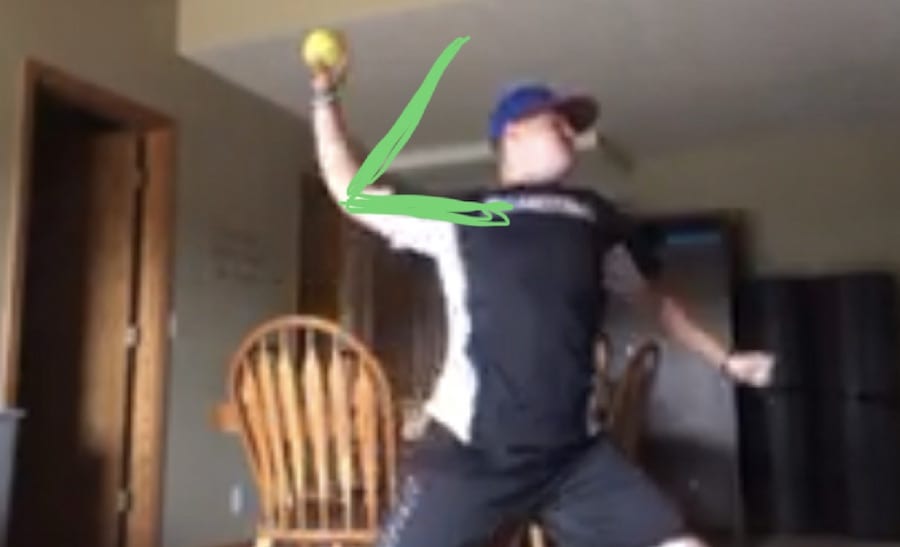
Below, you’ll see a similar angle in a baseball pitcher.

With a larger elbow angle, the arm as a whole is longer, meaning it takes more shoulder torque to rotate it, and more of that torque is transferred at the elbow.
Takeaway: the elbow angle should be slightly less than 90 degrees, and never more than 90 degrees.
A Drill to Fix This Throwing Flaw: Lawnmower Drill
The lawnmower drill helps a player feel the proper angle without doing those old, useless pause drills. A player starts by setting the angle we want, then moving through it in the drill.
Throwing Mechanics Flaw #2: Elbow Too High Before Throwing
A common throwing flaw I see is the elbow climbing too high above the shoulder line. This is especially common in fastpitch players who also pitch–the windmill pitching motion blends with the throwing motion.
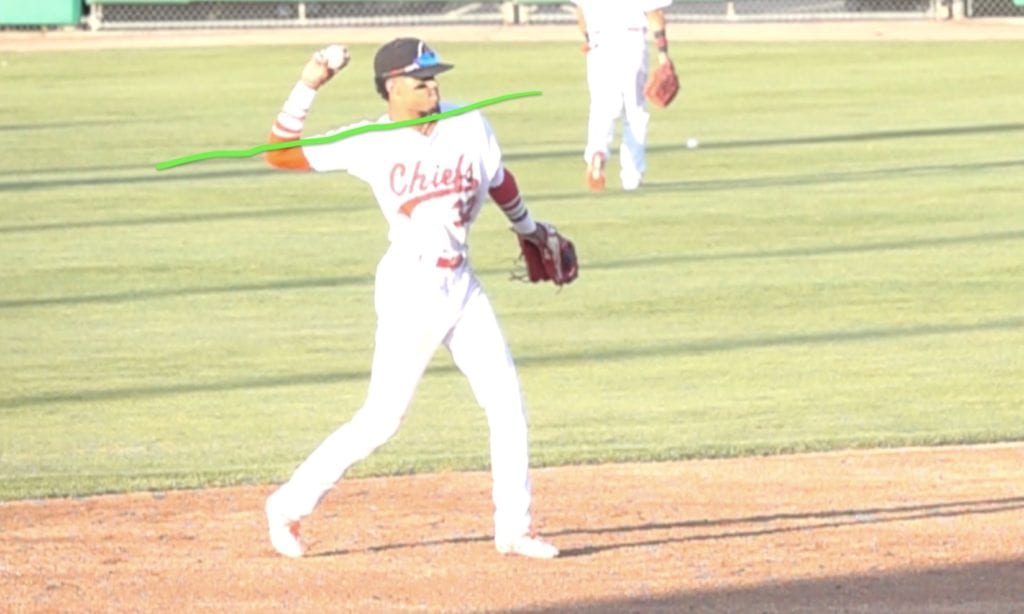
Basically what happens is this: when the elbow climbs too high, it has nowhere to go but down–leading to a low elbow and poor throwing speed.
And, being above the shoulder line causes shoulder impingement, which just means that the shoulder muscles get pinched between the bones of the shoulder. Neither thing is good.

A low throwing elbow not only causes poor throwing velocity and accuracy, but also increases stress as well. A chief causes of it is the elbow climbing too high in the early part of the motion. Typically, this is caused by two issues:
- A poor hand break (and what the hands should do is a common misconception)
- The shoulder blades not pinching back.
But, we can fix these issues.
All About The Hands and How They Separate:
A Video Explaining The Shoulder Blades’ Role in the Softball Throw:
Takeaway: the hand break and the way the shoulder blades move in the softball overhand throw will influence the elbow and shoulder stress. Fixing how the hands separate and the movement of the shoulder blades should reduce stress and increase power.
Softball Throwing Flaw #3: Poor Shoulder-Hip Separation
Shoulder-hip separation is an important concept in understanding how the body works as a unit.
Basically, little kids throw by moving their hips at the same time as their upper body. I don’t have a video of this, so let’s go back to a baseball pitcher we used earlier:
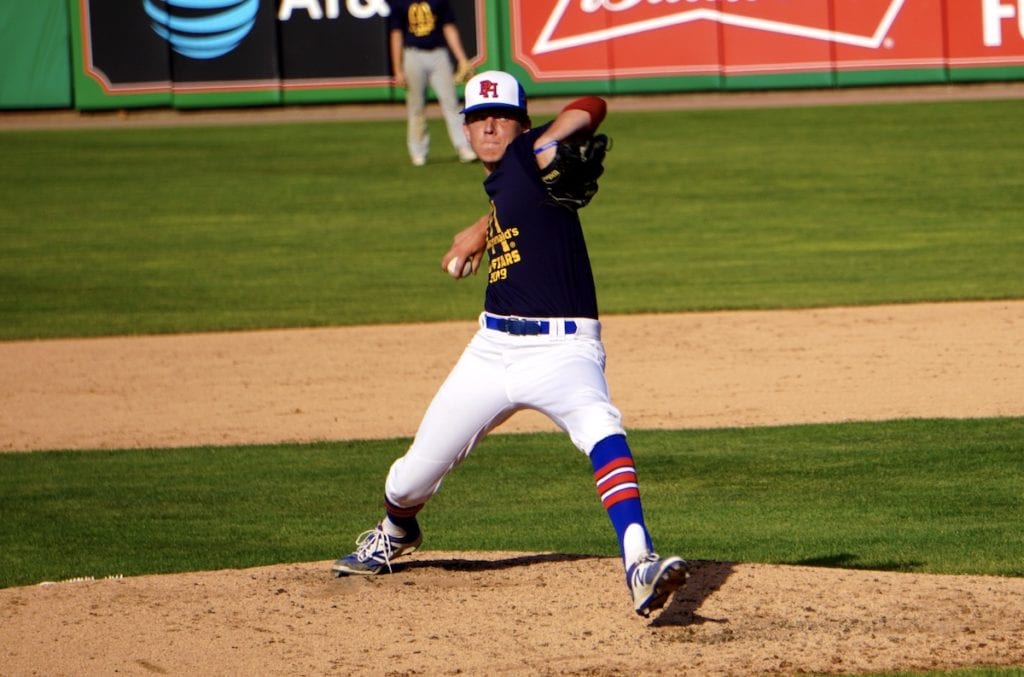
In the photo above, you’ll see how this pitcher separates his upper from lower half with some pretty crazy flexibility.
EVERY hard thrower does this. Yet, many who don’t throw well lack it. When a player doesn’t have good separation, they don’t get as much power out of their hips and core and legs, which means they have to produce more of their power with their arm.
Takeaway: Better separation = more velocity coming from the body, not the arm AND less stress being placed only on the arm itself.
Watch the video below for a better explanation.
Fix These Throwing Flaws and Reduce Stress on the Arm
Again, the following throwing flaws and drills to improve your softball throwing motion are NOT prescription–I can’t possibly tell you if one or another will cure a softball player’s pain.
Yet, following the research on what good throwing mechanics look like is the best thing to do. It’s good preventative medicine and should have a positive effect.
Just remember:
- ALWAYS see a doctor with arm pain. Don’t assume it’s nothing–it may not be.
- Preventative training is key! Shoulder strengthening and a progression to work on throwing mechanics is important for every player.
- Find a qualified coach or professional (including myself) who can help you improve your throwing motion and look for possible issues that may be causing pain, or might in the future.
Need More Throwing Help?
If you need more throwing expertise, consider taking the following actions:
- Sign up for my weekly softball emails. 3000+ people receive them each week, as I send out new videos and articleslike this one.
- Enroll in one of my softball online throwing courses. I have a course for every budget.
- Email me if you’re interested in remote coaching, throwing analysis or have questions. Most remote coaching I do through the VIP option of my course.
